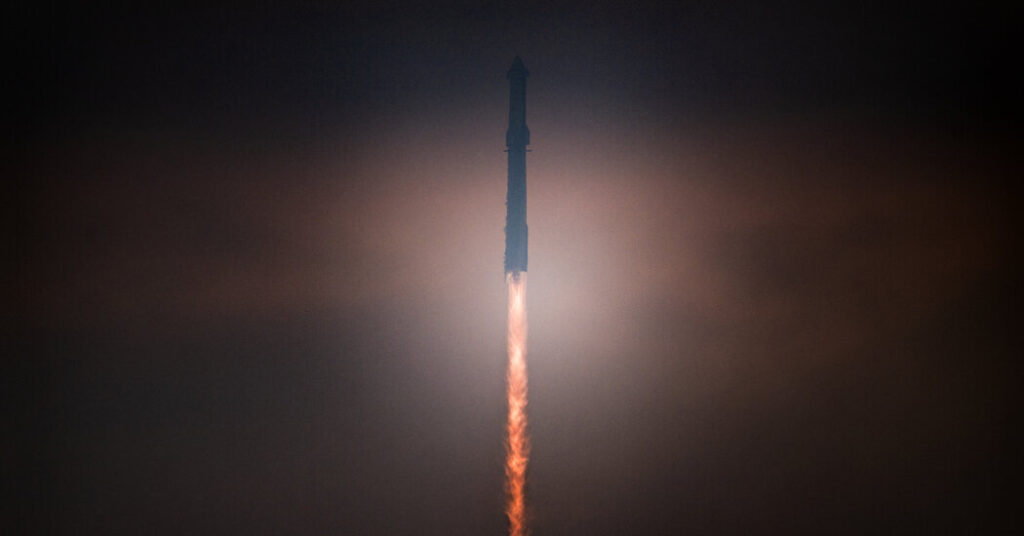SpaceX’s launch of its giant Starship rocket met a number of ambitious goals Thursday that Elon Musk, the company’s chief executive, launched ahead of its fourth test flight.
The flight, while not a perfect success, offered a sign that Mr. Musk’s vision to build the most powerful rocket ever and make it reusable could once again transform a global space-launch industry that his company already dominates. It’s likely to be encouraging to NASA officials, which will use a version of Starship to take astronauts to the surface of the Moon during its Artemis III mission, currently scheduled for late 2026.
Bill Nelson, the NASA administrator, offered his congratulations to X, the social networking site owned by Mr. Musk.
“We’re another step closer to returning humanity to the Moon via #Artemis – then look ahead to Mars,” he wrote.
The Starship upper stage vehicle lifted off into space, flew halfway around the world, survived the extreme heat of re-entry, and then made a water landing in the Indian Ocean as planned.
During the descent, cameras on the spacecraft captured the colorful glow of the gases heating up beneath it. At an altitude of about 30 miles, part of one of the rudder caps began to disintegrate, but it still held together. The view was then obstructed when debris cracked the camera lens.
“The question is how much of the ship is left,” said Kate Tice, one of SpaceX’s broadcast executives.
But real-time data continued to stream, relayed via SpaceX’s Starlink Internet satellites, to the company’s headquarters in Hawthorne, California, until the altitude was reported at 0 — back on the surface of the Indian Ocean.
A final maneuver to return the Starship to a vertical position just before landing was ordered.
“Despite the loss of many plates and a damaged collision, the Starship made it to a soft landing in the ocean!” Mr. Musk wrote in X.
A crowd of SpaceX mission control employees cheered wildly, seeing the result as a validation of the company’s approach to engineering.
Earlier in the flight, the rocket’s first stage, the giant Super Heavy booster with 33 engines, was also able to perform maneuvers that would later return it to the launch site. For this flight, he made a simulated landing in the Gulf of Mexico.
What is Starship and why is it important?
With the Starship spacecraft atop what SpaceX calls a Super Heavy booster, the rocket system is, by almost any measure, the largest and most powerful ever.
The rocket is the tallest ever built – 397 feet tall, or about 90 feet taller than the Statue of Liberty, including the pedestal.
The rocket also has the most engines ever in a booster: The Super Heavy has 33 of SpaceX’s powerful Raptor engines coming out of its tail. As these engines lift the Starship off the launch pad, they will generate 16 million pounds of thrust at full throttle.
For Mr. Musk, Starship is really a Mars ship. He envisions a fleet of Starships transporting settlers to the Red Planet.
For NASA, the vehicle will be a lunar lander, carrying astronauts to the surface of the Moon for the first time since 1972.
In the near term, SpaceX also plans to use Starship to deploy the next generation of Starlink Internet communications satellites.
An even more transformative feature of the Starship is that it is designed to be completely reusable. This capability has the potential to lower the cost of sending cargo into orbit — such that sending 100 tons into space one day could cost less than $10 million, Mr. Musk has predicted.
What was SpaceX trying to accomplish with this flight?
A few weeks ago, after a successful launch test, Mr. Musk wrote in X that for this flight, “The primary goal is to get past the maximum re-entry heat.”
In other words, he didn’t want the vehicle to burn.
During launch, the Starship reaches orbital speeds of more than 17,000 miles per hour while reaching an altitude of 145 miles. As the spacecraft re-enters the atmosphere, it experiences temperatures of up to 2,600 degrees Fahrenheit.
On Thursday, Starship endured that heat and then landed in a remote part of the Indian Ocean. Another goal was to soft land the first stage, the Super Heavy booster, in the Gulf of Mexico.
During future operational flights, both vehicles must return to the launch site and be captured in one piece by the launch tower. These efforts are still in the future.
What happened on the last flight?
The previous launch in March first reached speeds fast enough for the Starship to enter orbit. The liftoff included a new breakthrough twist: hot-stage separation, when several of the second-stage engines ignited before the Super Heavy booster, or first stage, separated and fell.
The Starship’s second stage portion accomplished several of its goals as it launched into space, including opening and closing the spacecraft’s cargo door and a demonstration of thruster movement between the two tanks inside the vehicle.
But while coasting to the highest point of its trajectory, the Starship began to spin out of control. On-board cameras captured the orange glow of hot plasma beneath the spacecraft. About 49 minutes after takeoff, it disintegrated, with communication lost at an altitude of 40 miles.
Earlier in the flight, the Super Heavy booster had to simulate a landing over the Gulf of Mexico. But six of the 13 engines used for that maneuver shut down early.
SpaceX blamed blockages in the flow of thrusters as the most likely cause of the Starship and Super Heavy booster losses. The company said it had made changes to address these issues.


